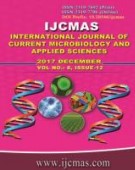


 National Academy of Agricultural Sciences (NAAS)
National Academy of Agricultural Sciences (NAAS)

|
PRINT ISSN : 2319-7692
Online ISSN : 2319-7706 Issues : 12 per year Publisher : Excellent Publishers Email : editorijcmas@gmail.com / submit@ijcmas.com Editor-in-chief: Dr.M.Prakash Index Copernicus ICV 2018: 95.39 NAAS RATING 2020: 5.38 |
The objective of this study was to investigate the ability of Cunninghamella phaeosphora UCP 1303 to produce biosurfactant converting soybean oil and corn liqueur, using temperature monitoring through the Arduino and DS18B20 waterproof temperature sensor. Initially, a 107 cells/mL suspension was inoculated and incubated under 150 rpm shaking at 25, 28 and 35°C during 96 h. Surface and interfacial tensions were determined by the Du Nouyring method and also the emulsification index and the dispersion test in water. The results demonstrated unprecedented use of Arduino in fermentation temperature control, with temperatures of 25°C and 35°C showing a surface tension reduction of 70 mN/m to 36.1mN/m and 70 mN/m for 37.1 mN/m respectively. Fermentation temperature at 28°C presented the best results for reducing surface tension (70 mN/m to 28.1 mN/m) and interfacial tension (2.2 mN/m) with high potential of motor oil emulsion Burned (E24 = 100%) and excellent dispersant properties (28.26 cm2) of motor oil burnt in water. The results showed that C. phaeospora produced biosurfactant in low cost medium using agroindustrial residues; in addition, the excellent properties of the biosurfactant suggest its potential of application in the bioremediation of sites polluted by hydrophobic compounds.
 |
 |
 |
 |
 |